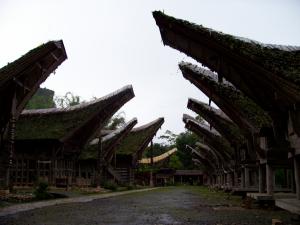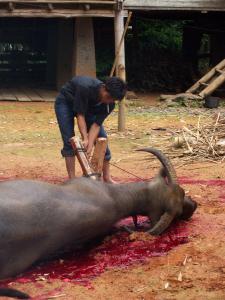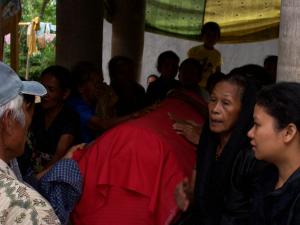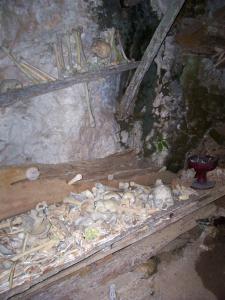
 Village
Village
Our motorbike weaved deftly between craterous potholes up the steep mountainside, and slowly drew to a halt on a narrow green verge outside a wooden homestead decked out in patterned red awnings. My guide, Hendrik, unleashed his jet black lady-killer mane from beneath his tiny motorbike helmet and told me to wait.
He wandered nonchalantly over to a group of men sitting on a wooden platform slamming down cardboard dominoes. A few puffs of cigarette smoke later, he returned and told me that the funeral had moved down to the next village. However, he exclaimed with a broad grin, it was my lucky day. The men were about to sacrifice the large placid buffalo chewing the cud on my left in order to expedite the deceased's journey to heaven.
Located on the bizarrely shaped island of Sulawesi, Indonesia, Tanah Toraja is the land of the Toraja people famed for their striking rituals of death. Guidebooks dedicate chunks to the region. Yet, with memories of the recent bombings in Bali, the beheading of three Christian schoolgirls in Poso and the fatal December bombing in Palu, (both a day’s journey to the north of Toraja), tourists are conspicuously absent.
Rantepao, the damp highland town which is the base for most visitors, is empty, cafes are silent and the hotels are dead. A tourist can easily achieve the pied piper effect with legions of children in crisp school uniforms yelling, "Hello mister!" and giggling at the unkempt foreigner.
The emerald Torajan countryside sprawls with its cloud covered peaks and snaking brown rivers beguiling all but the most jaded visitor. I went on the hunt for a funeral on a day punctuated by bursts of rain and a razor sharp blue sky.
The Torajans are mainly Christian, early 20th century Dutch Protestant missionaries having been very successful in proselytizing the masses, gleaming white churches fan out across the rice paddies. However, the Torajans have held onto many of their old beliefs surrounding the rituals of life and death.

 Sacrifice
Sacrifice
The dead’s journey to the afterlife is made smooth by the sacrifice of numerous buffalo and swine. The ill fated buffalo that was on my left was slowly tugged by the bronze ring in its nose onto the earthen ground at the centre of the homestead, its hind legs lashed to a stake. All eyes were on the buffalo as a teenager crept up to its neck and made a quick deep incision before bolting out of the way of the stunned bovine. Litres of blood shot onto the red earth and the buffalo twisted grotesquely around the stake, snorting until it slowly collapsed. As it lay quivering, bleeding profusely, the teenager returned and enlarged his earlier incision speeding up the animal's demise. My feeling of shock was not mirrored in the expressions on the faces of the Torajans, who quickly returned to their cigarettes and dominoes.
Hendrik put his hair back inside his helmet and we sped off down the mountainside in search of the funeral. In a valley, we reached another homestead filled with people dressed in sombre colours. This dwelling consisted of a few traditional tongkonan houses and lumbung, rice silos, with their upturned boat-shaped roofs built to honour their ancestors who migrated to Toraja from the Indochina region.

 Funeral
Funeral
The front of the house was adorned with a pole leading from the sweeping gable to the earthen floor. This pole was decorated with numerous buffalo horns, showing how many buffalo the family has sacrificed, which, in turn, is an indication of the family’s status. A visitor to a Torajan funeral must provide a gift, details are carefully logged for return at a future ritual of significance. A gaggle of toothless women huddled under some shade at the entrance, sold me a carton of kretek clove cigarettes. Hendrik led me through the crowds of bubble blowing children and bobbing chickens towards the family of the deceased. His presence ensured me the necessary invitation. Generally, foreigners are made to feel quite welcome; the more guests who attend a funeral, the more honour is bestowed upon the dead.
The cigarettes were handed over to the dead man's son, a young farmer, who warmly shook my hand and bade me sit down with the family. Though all members of the family were decked out in black, ladies wore black veils, everyone smiled. Typical in Toraja, the man had died a year and a half ago and had been "sleeping" in the family home until today.
The corpse is kept preserved by means of a pragmatic mixture of herbs and chemicals in a sealed coffin until the family has accrued the finances necessary to provide a decent funeral. This is no mean feat considering a farmer might earn between one to two million rupiah a month ($140.00 to $280.00 U.S.). The price of a buffalo is between six to 60 million rupiah. Depending on social status, a minimum of 25 rupiah is needed, plus a substantial number of pigs. A good send off often requires the calling in of many favours and ritual demands.
The family offered me tea and with much laughter, produced an orange jerry can of balok fermented rice wine. It looked like milky water and tasted similar to effervescent vinegar. After downing one glass to many cheers, another was duly poured and I was presented with some food. I had the choice of quivering fatty pork with wrinkly black skin, or a stick of glutinous rice. I played the trusty vegetarian card, chose the rice, sat back down to the sound of pigs squealing as they were dispatched behind one of the buildings.
A gong rang beneath the biggest tongkonan to inform the family it was time to move the body from the house to beneath one of the rice silos. A Torajan funeral lasts between four and five days while the body is moved around the homestead. Educated in intellectual Yoygyakarta, Java, Hendrik lamented this drawn-out procedure and with a conspirational wink, whispered that he had told his parents to throw him into the sea when he dies. The family carried the coffin, draped in red out of the house and beneath a rice silo where people gathered around, patted it slowly whilst continuing their village gossip. A keen villager buzzed around the crowd getting it all on video. Eventually, the body would be interred in a rock tomb on a mountainside.

 Coffin
Coffin
The Torajans used to bury their dead in wooden coffins placed on the side of cliffs. After dodging several rainstorms, Hendrik brought me to one such area to the south of Rantepao. The coffins had rotted away, in many cases they were simply platforms piled high with bones and skulls. Amongst these bones were cigarettes and damp bank notes, thrown in as offerings. In carved niches in the wall were macabre doll-like effigies. These are known as tau taus, effigies of the dead. Some niches contained whole families of intricately carved tau taus, staring blankly out to their mortal remains. Nowadays, the Torajans prefer to bury their dead in special tongkonan reserved for the family, or inside rock tombs in the countryside with photos instead of tau taus. You can't escape the omnipresent feeling of being watched by these photos and tau taus on a drive around Tanah Toraja.
Hendrik is confident that the tourists will return in the summer high season, hoping the terrorist atrocities have ended with the demise of leading perpetrator, Azahari. I am sure Toraja and Indonesia will again buzz with tourists and nationwide cheeky yells of "Hello mister!" Toraja should be well on the beaten path, not only as a place to see death, but also for the people who are very much alive.
You can email Paul Dixon at [email protected]